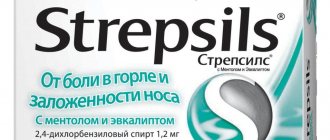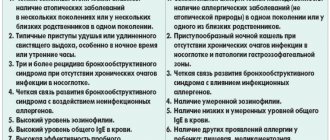Candidate of Medical Sciences, Associate Professor Bovbel I.E.
The prescription of antitussive, expectorant or mucolytic drugs is one of the main areas of symptomatic treatment of respiratory tract diseases in children and adolescents. A wide range of drugs that affect cough creates certain difficulties in choosing a drug for treatment.
Cough (tussis) is a complex protective reflex aimed at removing foreign substances from the respiratory tract that come with inhaled air and/or pathologically altered tracheobronchial secretions. Irritation of the nerve endings of the n.vagus, located in the respiratory tract, and the receptors of the pleura leads to the transmission of nerve impulses to the cough center of the medulla oblongata. Thanks to the activation of the cough center and with the participation of the reticular formation, a response is formed - inhalation, then synchronous contractions of the muscles of the larynx, bronchi, chest, abdomen and diaphragm occur with the glottis closed, followed by its opening and forced jerky exhalation.
Foreign particles and microorganisms entering with inhaled air are deposited on the mucous membranes of the respiratory tract and are subsequently excreted along with mucus. Under physiological conditions, the main mechanism for clearing the tracheobronchial tree is mucociliary clearance and peristalsis of the small bronchi. Cleansing of the respiratory tract occurs due to the coordinated and cooperative activity of the ciliated epithelium of the trachea and bronchi. Under normal conditions, cough, unlike mucociliary clearance, does not play a decisive role in clearing the respiratory tract and is of auxiliary importance in the processes of sanitation of the respiratory tract.
Mucolytic therapy: a rational choice
Table 1. Classification of mucolytic drugs according to their effect on bronchial secretion (according to [7] as modified)
In response to exposure to a damaging infectious or non-infectious agent, the first reaction of the mucous membrane of the tracheobronchial tree is the development of an inflammatory reaction with hypersecretion of mucus. One of the constant signs of inflammatory diseases of the respiratory system is cough, aimed at protecting and restoring the patency of the tracheobronchial system by removing secretions [1]. The effectiveness of the drainage function of the tracheobronchial tree is largely determined by the amount and rheological properties of sputum (viscosity, elasticity, adhesiveness), which can be improved by using expectorants and mucolytics [2, 3].
The use of expectorants (expectants), mainly preparations based on medicinal plants, is not always justified due to their short-term effect (small doses are required every two to three hours). An increase in their single dose causes dyspeptic disorders (nausea, less often vomiting and diarrhea), and an increase in the volume of sputum leads to a significant impairment of the drainage function of the lungs [4].
Mucolytic (secretolytic) therapy is aimed at inhibiting the formation of bronchial secretions, liquefying, rehydrating sputum and stimulating its removal from the lumen of the tracheobronchial tree. Mucolytics are the main component in the complex therapy of chronic bronchopulmonary diseases [5, 6].
Mucolytic agents (N-acetylcysteine, bromhexine, ambroxol, carbocysteine, erdosteine and guaifenesin) act on the gel phase of bronchial secretions and effectively dilute sputum without significantly increasing its quantity [4]. The mechanism of action of individual representatives of mucolytics is different, so they have different effectiveness (Table 1).
Based on their origin, mucolytic drugs are divided into two groups:
- synthetic (bromhexine, ambroxol, acetylcysteine, carbocysteine, mesna and erdosteine);
- natural origin:
- enzymes (trypsin, chymotrypsin, pankypsin, ribonuclease, deoxyribonuclease, elastolin, caripazin);
- herbal remedies that, along with mucolytic, also have an expectorant effect [8].
Some of the mucolytic drugs have several dosage forms that provide different methods of drug delivery (inhalation, oral, injection, endobronchial), which is extremely important in the complex therapy of respiratory diseases.
N-acetylcysteine
(
acetylcysteine, ACC, muconex, fluimucil, etc.
) is an active mucolytic drug. The mechanism of its action is based on the rupture of disulfide bonds of acidic mucopolysaccharides of sputum, which helps to reduce the viscosity of mucus [9]. The drug also helps to liquefy pus and thereby increases its evacuation from the respiratory tract [4, 10]. N-acetylcysteine increases the secretion of less viscous sialomucins and alveolar surfactant by type II alveolocytes, enhances the motor activity of cilia by reducing the viscosity of sputum, and can increase antiviral immunity [11]. In addition, N-acetylcysteine promotes the synthesis of glutathione, the body’s main antioxidant, which enhances cell protection from the damaging effects of free radical oxidation, which is characteristic of an intense inflammatory reaction [12, 13].
When using N-acetylcysteine, it is necessary to take into account the possible danger of developing bronchospasm, as well as a decrease in the production of lysozyme and secretory immunoglobulin A (IgA) [4]. Long-term treatment with the drug causes suppression of the activity of ciliated cells [13]. Taking N-acetylcysteine is contraindicated for gastric and duodenal ulcers in the acute stage, during pregnancy and breastfeeding [14].
Mucolytics-mucoregulators (carbocysteine) and vasicinoids (bromhexine and ambroxol) do not cause bronchial constriction.
Bromhexine
(
Bisolvon, Solvin, Flegamine, etc.)
– a synthetic derivative of the alkaloid vasicine. Bromhexine is one of the first synthetic mucolytic drugs and has been widely used in the treatment of respiratory diseases for several decades. When taken orally, bromhexine, which in the body turns into an active metabolite - ambroxol, has an expectorant and mucolytic effect.
The pharmacodynamic effects of bromhexine are less pronounced than those of ambroxol [4]. The mechanism of the mucolytic action of the drug is associated with depolymerization and destruction of acidic mucoproteins and mucopolysaccharide polymer molecules of bronchial secretions, which leads to a decrease in its viscosity [15]. Also important is the ability of bromhexine to restore mucociliary clearance by stimulating the synthesis of endogenous surfactant by type II alveolocytes [5]. In addition, the drug stimulates the synthesis of neutral polysaccharides and the release of lysosomal enzymes [7], promotes the release of sputum from the respiratory tract, increasing the activity of the ciliated epithelium of the bronchi [16], and has a weak antitussive effect [2].
Among the side effects, gastrointestinal disorders and skin reactions, which are observed quite rarely, attract attention. Bromhexine is not recommended for pregnant women and nursing mothers [14, 17].
The second representative of vasicinoids is ambroxol
(
Ambrobene, Ambrohexal, Ambrosan, Bronchopront, Lazolvan, Medox, Flavamed, Halixol, etc.)
belongs to the new generation of mucolytic agents. Ambroxol causes depolymerization of mucoproteins and mucopolysaccharides, providing a mucolytic effect. The drug activates the movements of the cilia of the ciliated epithelium, providing a secretomotor effect and restoring mucociliary transport [4, 16]. Ambroxol is able to increase the synthesis of surfactant and inhibit its breakdown under the influence of unfavorable factors [18, 19].
The drug has an anti-inflammatory effect due to inhibition of neutrophil chemotaxis and suppression of the production of anti-inflammatory cytokines (interleukin-1, tumor necrosis factor), as well as anti-edematous and antioxidant effects [12, 20]. Ambroxol, by suppressing the production of anti-inflammatory cytokines by O2-activated neutrophils, prevents the accumulation of hypochlorous acid in neutrophils [21]. The drug enhances the natural defense of the lungs by activating tissue macrophages and increasing the production of secretory IgA [22]. Ambroxol does not have a teratogenic effect, and therefore can be used in pregnant women and children, in particular for the prevention and treatment of respiratory distress syndrome [23].
Side effects when using ambroxol are rare and manifest themselves in the form of nausea, abdominal pain, allergic reactions, dry mouth and nasopharynx. The drug is not used in conjunction with antitussives, as this contributes to the accumulation of bronchial secretions in the respiratory tract [1].
For inflammatory diseases of the respiratory tract, combination drugs are often used, including in combination with antibiotics. When prescribing mucolytics and antibiotics simultaneously, their compatibility must be taken into account: bromhexine and ambroxol increase the penetration (penetration) of antimicrobial agents into the bronchial secretions and bronchial mucosa (primarily this applies to amoxicillin, ampicillin, cefazolin, cefuroxime, erythromycin, doxycycline and sulfonamides) [17 ]. A number of studies have shown an increase in the concentrations of antibiotics of various groups (penicillins, cephalosporins, macrolides, tetracyclines and fluoroquinolones) in the alveoli and bronchial mucosa under the influence of ambroxol [24, 25]. This may be a significant factor influencing the effectiveness and duration of antibiotic therapy for respiratory tract infections.
Carbocisteine
(
Bronchobos, Libexin Muco, Mucodin, Fluifort (carbocysteine lysine salt), Fluditek, etc.
) is a representative of mucolytic-mucoregulators. Carbocysteine activates sialic transferase of goblet cells of the bronchial mucosa, under the influence of which the production of acidic mucins involved in the organization of bronchial secretions slows down and, as a result, helps improve its viscosity and elasticity [26]. The drug also restores impaired IgA secretion, normalizes and stimulates the secretion of glutathione in the epithelial cells of the mucous glands, and has pronounced anti-inflammatory and immunomodulatory activity [2, 7].
Considering the existing data on the ability of carbocysteine to increase the activity of regeneration of the bronchial mucosa and reduce the number of goblet cells, especially in the terminal bronchi, to potentiate the activity of ciliated cells in the chronic nature of the inflammatory process in the tracheobronchial tree, the combined use of ambroxol and carbocysteine is possible [8, 26].
Possible side effects of carbocisteine include nausea, stool disorders, epigastric pain and allergic reactions. Carbocisteine is not advisable to combine with antitussive drugs; it is not recommended for pregnant women and nursing mothers [2, 14].
Erdostein
(
Erdosteine
) is a new mucolytic drug, is a derivative of homocysteine, has mucolytic and antioxidant properties, as well as a moderate antitussive effect. Unlike acetylcysteine, it reduces the formation of reactive oxygen species [27]. Erdostein prevents the adhesion of bacteria to the mucous membrane of the respiratory tract due to the fact that the sulfhydryl groups of its active metabolites destroy disulfide bonds in the protein molecule that is part of the bacterial cell [28]. Erdostein also prevents the inhibition of α1-antitrypsin synthesis and increases the concentration of IgA in the mucosa in patients with obstructive airway diseases [29].
The simultaneous administration of erdosteine and amoxicillin in patients with infectious exacerbation of chronic bronchitis led to an increase in the concentration of the antibiotic in sputum, a decrease in its viscosity and a more rapid disappearance of clinical symptoms compared to ambroxol and placebo [30].
Erdostein does not have a damaging effect on the gastrointestinal tract; in case of renal failure and impaired liver function, accumulation of drug metabolites in the body is possible [27].
Guaifenesin
(
Jocet, Toussin, etc.
) is a derivative of guaiacol (o-methoxyphenol). Guaifenesin, in its characteristics, occupies an intermediate position between expectorants and mucolytic drugs. It stimulates mucus secretion and reduces its viscosity [15]. Unlike expectorants of reflex and resorptive action, the pharmacological effect of guaifenesin is based on reducing the surface tension and adhesion of mucus to the bronchial mucosa due to the depolymerization of acidic mucopolysaccharides of mucus, which reduces its viscosity and facilitates evacuation from the respiratory tract [31]. The ability to increase mucus secretion (albeit less viscous) makes guaifenesin similar to expectorants [32].
No side effects have been noted with guaifenesin, however, when taking it, urine may turn pink. The drug is contraindicated in cases of hypersensitivity to the drug, pregnant and lactating women, and children under 3 years of age. Guaifenesin should be used with caution in patients with gastric ulcers [14, 32].
It is advisable to combine guaifenesin with sputum thinners. It is part of such combination cough preparations as Ascoril
,
Hexapneumin
,
Kalmilin for coughs and colds
,
Coldrex broncho
,
Prothiazine expectorant
,
Pulmotin
,
Robitussin
,
Stoptussin
,
Synetos
,
Tussin plus
, and is also found in combination drugs with phenylpropanolamine (sympathomimetic), theophylline (phosphodiesterase inhibitor), codeine (narcotic analgesic) , phenylephrine (α-adrenergic stimulant), pseudoephedrine
( sympathomimetic) [14].
Proteolytic enzymes
(trypsin, chymotrypsin, RNase) reduce both the viscosity and elasticity of sputum, have an anti-edematous and anti-inflammatory effect. However, these drugs are practically not used in pulmonology due to possible damage to the pulmonary matrix and the risk of developing side effects such as bronchospasm, hemoptysis and allergic reactions, especially in pediatric practice. An exception is recombinant aDNase, which is prescribed to patients with cystic fibrosis [4].
Combination drugs
used as symptomatic therapy for acute and chronic inflammatory diseases of the respiratory tract. Due to the bronchodilator and anti-inflammatory effects, when taking these drugs, a dry, obsessive cough is stopped, and thanks to the expectorant and mucolytic effects, it is transformed into a wet one and the respiratory tract is sanitized.
Some combination drugs contain an antitussive drug ( Stoptussin, Hexapneumin, Lorraine
), bronchodilator (
ascoril, solutan
), antipyretic and/or antibacterial agents (
Hexapneumin, Lorraine
).
These drugs should be prescribed only for strict indications, since some of them contain medications that are opposite in their effects or suboptimal doses of active substances, which reduces their effectiveness. But there are also completely justified combinations of drugs (for example, Ascoril expectorant
, which includes guaifenesin, bromhexine and salbutamol) [33].
Thus, the choice of one or another mucolytic agent or their combinations in the complex therapy of inflammatory diseases of the respiratory system, which are accompanied by a productive cough, should be strictly individual and should take into account the mechanism of pharmacological action of the drug, the phase and nature of the pathological process, the patient’s age and the presence of concomitant pathology. The simultaneous use of antitussive and mucolytic drugs is undesirable, but a positive effect can be obtained by using mixed action mucolytics with antitussive properties (erdostein). In acute bronchitis and pneumonia with scanty sputum, a combination of expectorants and mucolytics is possible, or the prescription of guaifenesin, which has both expectorant and mucolytic effects, is justified. For diseases of the respiratory system with an acute and protracted course, accompanied by a cough with copious mucous sputum, the drug of choice can be considered carbocisteine (mucoregulator), and with viscous and (or) purulent sputum - ambroxol. In children, the drugs of choice are also ambroxol and carbocysteine, in a balanced combination of which the drugs complement each other's actions, relieving cough and promoting rapid restoration of the mucous membrane of the respiratory tract. In case of chronic pathology of the respiratory system, N-acetylcysteine is prescribed as maintenance therapy for a long period. In acute diseases of the respiratory system and exacerbation of chronic inflammatory diseases of the lungs, a combination of mucolytic drugs with expectorants is possible, but the effectiveness of the latter in chronic pathology of the respiratory tract is low, which is associated with the presence of irreversible structural changes in the bronchial epithelium.
Introduction
Hypersecretion of mucus into the lumen of the respiratory tract is a characteristic feature of a number of pulmonary diseases, such as acute and chronic bronchitis (CB), chronic obstructive pulmonary disease (COPD), cystic fibrosis (CF), bronchiectasis and bronchial asthma (BA).
Regular cough with sputum production (productive cough) together with impaired mucus drainage are significant in the clinical assessment of the severity of pulmonary disease and an argument for the prescription of mucolytic and mucoactive drugs. The main effect of mucolytic drugs is their effect on the viscosity of secretions, the volume and nature of mobilization of sputum from large and small bronchi [1]. The modern classification of mucoactive drugs is simple and based on their main action. It is customary to distinguish expectorants (expectorants), mucolytics, mucokinetics and mucoregulators. Expectorants enhance the secretion of mucins and increase their hydration (guaifenesin, hypertonic solution). Mucolytics (N-acetylcysteine, carbocysteine, dornase alpha) significantly reduce the viscosity of mucus. Mucokinetics actively change the movement of the cilium, increase the mobilization of secretions and “ease” cough (ambroxol, β2-adrenergic agonists, surfactant) [2].
We paid special attention to a prominent representative of the group of mucokinetics - vasicinoid or “ambroxol” - the only eighth metabolite of bromhexine, which has a pronounced stimulating effect on mucociliary clearance (MCC). This interest in ambroxol is associated with a progressively increasing number of randomized clinical studies showing its high effectiveness in respiratory diseases with hypersecretion of secretions (COPD) [3], exacerbations of chronic disease [4–8], in patients with CF [9, 10], during therapy newborns with hyaline membrane disease (respiratory distress syndrome of newborns) [11, 12], in patients with asthma [13], with antioxidant therapy [14], to prevent bronchopulmonary complications after thoracic interventions [15], in acute diseases of the upper respiratory tract [ 16], with pulmonary alveolar proteinosis [17]. Experimental studies on animals are exploring the possibility of using ambroxol to reduce fibrosis of lung tissue [18].
Chemical formula and primary pharmacology of ambroxol
Ambroxol hydrochloride (C13H18Br2N20) is a benzylamine derivative, the active N-desmethyl metabolite of bromhexine hydrochloride (2-amino-3,5-dibromo-N-methylbenzylamine hydrochloride), which is a synthetic derivative of vasicin, a substance obtained by extraction from the herb Adhatoda vasica (Adatoda vascularis), a plant known in medicine for several centuries, which has anti-inflammatory, analgesic, expectorant, diuretic, anti-asthmatic and abortifacient effects, is an antiseptic and insecticide, has a sedative and antispasmodic effect.
The mechanism of action of ambroxol has been thoroughly investigated in numerous pharmacological and clinical studies. It consists of a mucokinetic effect [19], mucociliary activity [19], stimulation of surfactant production [20, 21], anti-inflammatory and antioxidant effects [22], as well as local analgesic (anesthetic) properties [23, 24].
Mucokinetic action and mucociliary activity
In animal studies (anesthetized rabbits and guinea pigs), ambroxol hydrochloride significantly increased bronchial secretion in a dose-dependent manner (dose-dependent effect) [25–27]. The best way to deliver ambroxol is the inhalation route to ensure direct intratracheal action.
In animal studies of isolated bronchopulmonary preparations (rats, hamsters, cats), ambroxol stimulated ciliary activity [28]. It should be noted that a significant increase in the frequency of ciliary contractions was found in cells of the isolated trachea of guinea pigs [19]. In an in situ study on frog esophagus preparations, a dose-dependent significant effect of enhancing mucus transport was shown with topical application of ambroxol [29]. It has been established that high mucociliary activity is inherent in ambroxol, especially with its topical intrabronchial administration.
Stimulation of the surfactant system
The special properties of ambroxol are associated with the activation of the surfactant system of the lungs. Surfactant has been shown to have the property of blocking the adhesion of mucus to the walls of the bronchial tree, which facilitates mucus transport [29]. Ambroxol stimulates the production of surfactant by type II pneumocytes (alveolocytes) [30]. Regulation of surfactant levels may be a major mechanism of protection against influenza A virus infection [31]. Rats treated with ambroxol at doses of 100 and 200 mg/kg orally for 3 and 6 days showed a sharp volumetric increase in type II alveolocytes in the lungs with a significant increase in the percentage of lamellar bodies to the total area of alveolar tissue [32]. Treatment of rats with ambroxol (200 mg/kg/day orally) was accompanied by an increase in the incorporation of 3H-palmitic acid into alveolar tissue, which leads to increased synthesis of pulmonary surfactant [33–35]. Surfactant stimulation with ambroxol has been shown in studies in premature and newborn animals. Treatment of pregnant rabbits with ambroxol (50 mg/kg intravenously) on days 24–26 of pregnancy led to an improvement in the pulmonary function of prematurely delivered premature fetuses [36–37]. Administration of ambroxol (4 mg/kg/day) to pregnant animals on days 21–24 of gestation caused a significant improvement in the maturation of lung tissue in 25-day-old preterm rabbits [38]. Moreover, the effect of ambroxol on adult animals (“minipigs” - small pigs) with acute respiratory distress syndrome caused by aspiration of hydrochloric acid was noted. Treatment with ambroxol led to the survival of all treated animals, while animals in the control group died within 12 hours [39].
Antioxidant and anti-inflammatory activity
The antioxidant properties of ambroxol are associated with the absorption of free radicals [40–44]. Research convincingly shows that ambroxol protects the bronchopulmonary apparatus from oxidative stress and free radicals generated by inhalation of tobacco smoke, toxic substances, activation of neutrophils and alveolar macrophages [45–46].
The anti-inflammatory properties of ambroxol have been proven in studies of the inflammatory effects of neutrophils, macrophages and mast cells. Ambroxol is endowed with the ability to alter the oxidative and proteolytic histotoxic activity of neutrophils by interfering at different levels [47]. Ambroxol significantly reduces lipopolysaccharide (LPS)-induced cytokine synthesis in rat alveolar macrophages, as well as LPS-induced nitric oxide production [48, 49].
Ambroxol significantly reduces histamine levels and the release of growth factor from human mast cells and monocytes, which are found in large numbers in the lungs, skin and intestines. It has been established that ambroxol weakens bronchoconstriction and actively suppresses the release of histamine and the synthesis of leukotrienes [50–53].
The anti-inflammatory properties of ambroxol were studied in an acute model of lung injury, in which it reduced LPS-induced pulmonary hemorrhage, edema, exudation and neutrophil infiltration. When treated with ambroxol, the concentrations of protein, tumor necrosis factor α, interleukin-6 and transforming growth factor β1 in bronchoalveolar lavage significantly decreased [54–57]. During influenza viral infection in experiments on mice, ambroxol suppressed the reproduction (multiplication) of the virus in liquid media of the respiratory tract, which significantly increased the survival rate of animals infected with influenza A virus. Unfortunately, the nature of this mechanism of action of ambroxol is not entirely clear and requires further study [58].
Local anesthetic (anesthetic) effect
The local anesthetic effect of ambroxol was first described back in 1977, but the underlying molecular mechanism of this effect remained poorly understood for a long time. Currently, there is irrefutable evidence that ambroxol is a powerful inhibitor of the neuronal voltage-dependent sodium channel, which is associated with its local anesthetic effect [59]. As a result, ambroxol is able to suppress cough and pain component (sore throat) in acute respiratory infections of the respiratory tract.
Clinical pharmacokinetics and metabolism
There are a variety of dosage forms of ambroxol: intravenous and intramuscular solutions, syrups, granules, tablets, capsules, suppositories and slow-release oral forms. After intravenous administration of ambroxol, its total plasma clearance is 660 ml/min, while renal clearance (53 ml/min) does not exceed 8% [60]. The volumetric distribution of ambroxol is high (about 560 liters with more than 17-fold accumulation in the lungs compared to blood plasma), due to which its half-life is considered long (10 hours). The absolute bioavailability of ambroxol after oral administration is 79%, and the sustained dose-dependent effect remains in the range from 30 to 500 mg for tablet forms. Absorption (absorption) is fast: Tmax – 1.6 hours. Plasma protein binding is 90% [61]. Ambroxol is mainly excreted from the body through biotransformation, the first phase of which is represented by metabolites of 3,5-dibromanthranilic acid, the second by various glucuronides. Cytochrome P450 3A4 has been shown to be responsible for the oxidative metabolism of ambroxol. However, no significant drug interactions have been identified with the use of ambroxol [62].
Clinical evidence of the effectiveness of ambroxol
Analysis of clinical data on the use of mucoactive substances in the treatment of non-infectious human diseases faces a number of significant difficulties. First, the vast majority of studies were performed more than 40 years ago, when “good clinical practice” (GCP) guidelines were not generally accepted. Second, research into the mechanisms of pulmonary disease associated with cough and sputum production was in its infancy. There were often no consent documents on the diagnosis and treatment of chronic respiratory diseases, such as chronic disease, COPD, emphysema, and asthma [63].
Clinical evaluation of the effect of chronic sputum-producing cough on morbidity and mortality in patients with pulmonary diseases was studied in the mid-1990s. It was found that in patients with sputum hypersecretion, 54% of deaths were caused by lower respiratory tract infection (LRTI) versus 28% in patients without sputum hypersecretion. Chronic sputum hypersecretion has become recognized as a reliable predictor of death in patients with COPD and associated with LRTI (relative risk - 3.5), in contrast to similar deaths among patients without LRTI (relative risk - 0.9) [64].
This made it possible to change approaches to further research on mucoactive drugs. The primary endpoints of the clinical trials were: 1) the effect of the drug on mortality; 2) the effect of the drug on exacerbations of the disease; 3) the effect of the drug on health and quality of life. From the database of clinical studies of ambroxol, we selected studies that complied with GCP requirements and were applicable for the correct assessment of the clinical effectiveness of treatments for acute and chronic respiratory diseases in adults.
Effects of treatment with ambroxol in adults
We divided all studies into short-term (<4 weeks) and long-term (>4 weeks). Given the requirement for randomization, blinding, placebo, or active control, only 3 of 24 short-term and 7 of 12 long-term studies were included in the analysis. Despite the positive results, the remaining studies were not considered due to poor design (open-label, uncontrolled, small number of patients, unspecified single doses).
Short-term studies of ambroxol (<4 weeks). Endpoints of short studies of ambroxol include only respiratory symptoms, mucus quantity/quality, cough productivity, bronchial flow parameters (forced expiratory volume in 1 second (FEV1), peak expiratory flow). All three studies indicate significant clinical efficacy of ambroxol in terms of improving respiratory symptoms, facilitating coughing, reducing mucus production [65], reducing sputum volume and viscosity [66], and reducing the number of patients who do not respond to therapy [67]. Spirometry was performed in all studies. Ambroxol had no effect on either FEV1 or PEF [65–67].
A study by Germouty and Jirou-Najou (1987) administered ambroxol along with an antibiotic and compared the effectiveness of the combination with placebo. It was found that ambroxol increased the concentration of the antibiotic in lung tissue and mucus. In a double-blind, placebo-controlled study, Fraschini et al. (1988) 60 patients with COPD with purulent sputum, divided into 3 groups, were prescribed amoxicillin, erythromycin or cefuroxime (all 1500 mg/day) together with ambroxol (90 mg/day) or placebo for 7 days. Antibiotic levels were measured in plasma and bronchial secretions on days 1 and 7 after 4 and 8 hours of drug administration. Compared with placebo, the combination with ambroxol significantly increased the level of the antibiotic in bronchial secretions (p<0.05), but not in plasma [68].
The short-term effects of ambroxol and some other mucolytics on pulmonary CBF in patients with COPD [69–74] are presented in the table.
In patients with COPD and severe MCB impairment, ambroxol significantly improved clearance, although overall changes remained moderate [73]. However, in studies examining the penetration index (i.e., the depth of distribution of labeled radioactive particles of a substance in the respiratory tract), ambroxol significantly increased it in each observation. The results obtained suggest that ambroxol helps reduce obstruction of small airways (bronchioles and bronchi) by increasing sputum clearance. This effect on the penetration index was also observed with bromhexine, in contrast to other mucolytics (guaifenesin, 2-mercaptoethane sulfonate, N-acetylcysteine), which never showed similar effects [71–74].
Long-term studies of ambroxol (>4 weeks). Five of the seven selected studies were randomized, double-blind, placebo-controlled [75–78]. In five of seven studies, the duration of ambroxol therapy exceeded 6 months, and the primary endpoints in 4 of them were the incidence of exacerbations of COPD and the number of days of disability [77]. Secondary endpoints of the study assessed sputum volume, physical status, symptoms of the disease (cough and sputum production), and respiratory function. The dose of ambroxol was 75 mg/day in studies longer than 6 months and 120 mg/day in two studies of shorter duration [78].
In the AMETHIST study (2004), the administration of high doses of ambroxol (120 mg/day) to patients with COPD who did not use inhaled glucocorticosteroids led to a decrease in the number of exacerbations, days of disability and the number of hospitalizations [7]. It has been noted that exacerbations of the disease (especially those requiring hospitalization) significantly increase the cost of treatment for patients with COPD [79].
It was found that ambroxol therapy did not change the parameters of external respiration function. Ambroxol had no effect on the symptoms of the disease, determined by the results of a questionnaire survey of the quality of life of patients with COPD. Despite the good study design (inclusion/exclusion criteria, statistical methods), the sample size of patients and the duration of follow-up did not fully meet the requirements for a full assessment of the QoL questionnaire. The weak effect of ambroxol on respiratory symptoms is explained by the short duration of mucolytic therapy, since most studies assessing the effects of long-acting bronchodilators and inhaled glucocorticosteroids on patients with COPD provide for a duration of therapy of at least a year [77–80].
Clinical safety of ambroxol
The drug form of ambroxol was introduced to the market in 1973. The safety of ambroxol in therapeutic use was analyzed in 15,000 patients in 100 studies assessing a total of 4,789,563 patient-years, as formally reported in the Periodic Safety Update Report. Rare reactions to the use of ambroxol include skin rashes, nausea and vomiting, abdominal pain, dyspepsia, and anaphylactic reactions. The incidence of adverse reactions did not exceed that for other mucoactive drugs.
In general, ambroxol can be regarded as a highly safe mucoactive substance, well tolerated by adults and children [81].
Modern doctrine of mucolytic therapy
During many years of medical practice, ambroxol was recognized as a substance with pronounced mucolytic, secretomotor effects, restoring the physiological mechanisms of clearing the airways, helping to prevent the “sticking” of viscous secretions, reducing airway resistance and enhancing bronchoalveolar aeration. Based on the therapeutic properties of ambroxol, its use is most rational in drug therapy regimens for patients with bronchopulmonary diseases and mucus hypersecretion. In this case, a separate group consists of patients who need to maintain “bronchial hygiene”.
The nebulizer method of drug delivery is preferable because it avoids side effects. The higher the concentration, the more pronounced the effects of ambroxol. It is recommended to initiate ambroxol therapy with the nebulizer delivery route, which has the following advantages: 1) wide dose variation; 2) local anesthetic effects (cessation of tickling and reduction of cough); 3) high topical concentration. Fine dispersion and high respirable fraction ensure the penetration of ambroxol into the distal sections of the bronchi, allowing for direct mucolytic, secretomotor, anti-inflammatory and antioxidant effects.
Ambroxol is advisable to use for anti-inflammatory and antioxidant therapy in patients with COPD. The effect of ambroxol to protect lung tissue begins at 2–3 weeks of therapy, and therefore a long-term regimen of long-acting forms of ambroxol at an average daily dose of 75–120 mg/day is recommended for a period of 1 to 12 months. The safety and effectiveness of this therapy were proven in the AME-THIST study [7].
Ambroxol therapy is indicated for acute lung injury (adult respiratory distress syndrome), when influencing the surfactant system is a priority. In such cases, both intravenous and inhalation delivery of the drug over a period of 6–8 months is advisable. Average daily therapeutic doses are recommended based on the patient's body weight.
There is a need for ambroxol therapy in patients with pneumonia. This strategy goes well with antibiotic therapy, as it helps to increase the accumulation of antibacterial agents in the affected lung. Obviously, the duration of such therapy should exceed one week. In such cases, it is advisable to expect the implementation of the antioxidant and anti-inflammatory effects of ambroxol. The use of this regimen for a month forms a stable “barrier protection” in people who have had pneumonia. There was a decrease in the frequency of subsequent relapses of viral infections and colds in such patients.
Conclusion
The use of dosage forms of ambroxol has been well studied in various forms of acute and chronic inflammatory diseases of the upper and lower respiratory tract. Analysis of the properties of ambroxol from the perspective of “evidence-based medicine” opens up new prospects for the use of vasicinoids in the modern strategy of mucolytic therapy.
Rational regimens of mucolytic therapy allow the practitioner to achieve a reduction in the number of exacerbations and hospitalizations of patients with chronic pulmonary diseases, and therefore significantly influence the prognosis and course of chronic diseases with hypersecretion of mucus and disorders of the physiological mechanism of mucociliary transport of bronchial secretions.









